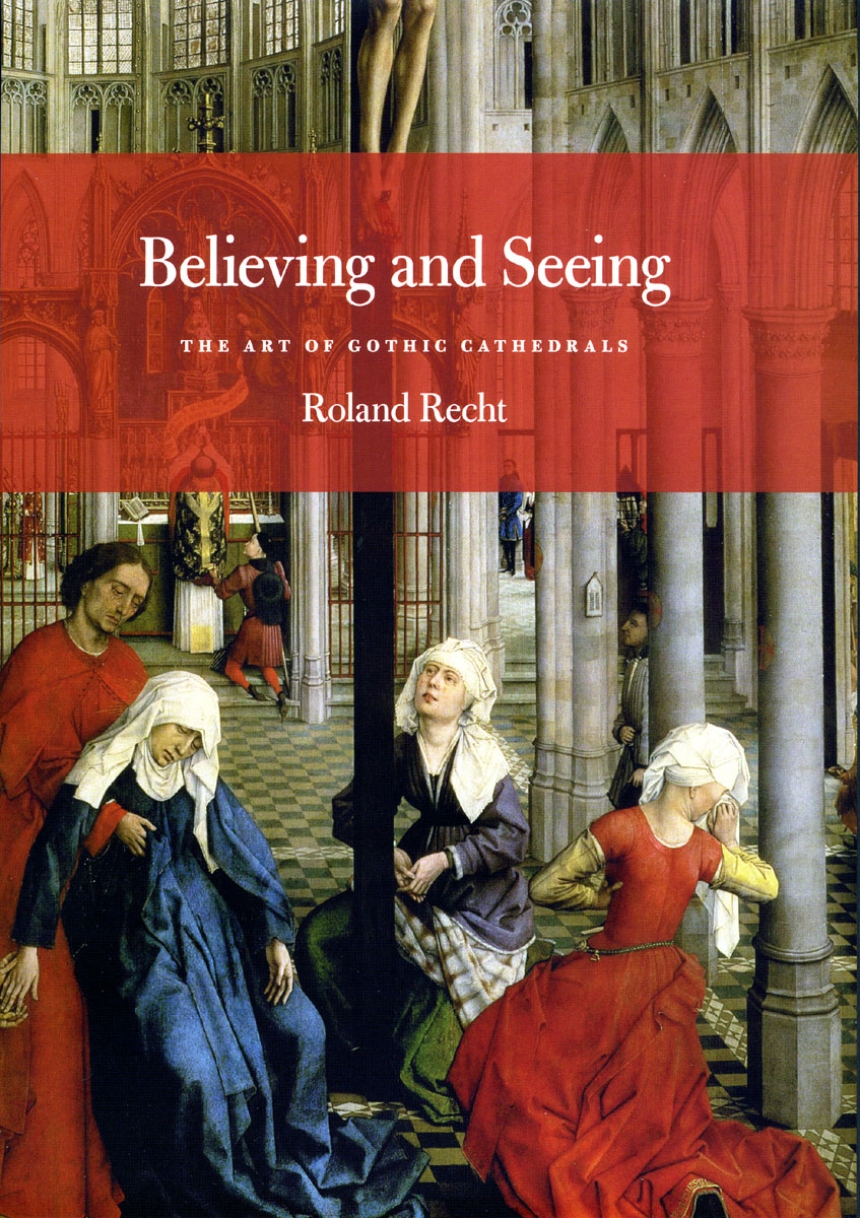Believing and Seeing
The Art of Gothic Cathedrals
Developments in medieval science that elevated sight above the other senses found religious expression in the Christian emphasis on miracles, relics, and elaborate structures. In his incisive survey of Gothic art and architecture, Roland Recht argues that this preoccupation with vision as a key to religious knowledge profoundly affected a broad range of late medieval works.
In addition to the great cathedrals of France, Recht explores key religious buildings throughout Europe to reveal how their grand designs supported this profusion of images that made visible the signs of scripture. Metalworkers, for example, fashioned intricate monstrances and reliquaries for the presentation of sacred articles, and technical advances in stained glass production allowed for more expressive renderings of holy objects. Sculptors, meanwhile, created increasingly naturalistic works and painters used multihued palettes to enhance their subjects’ lifelike qualities. Reimagining these works as a link between devotional practices in the late Middle Ages and contemporaneous theories that deemed vision the basis of empirical truth, Recht provides students and scholars with a new and powerful lens through which to view Gothic art and architecture.
In addition to the great cathedrals of France, Recht explores key religious buildings throughout Europe to reveal how their grand designs supported this profusion of images that made visible the signs of scripture. Metalworkers, for example, fashioned intricate monstrances and reliquaries for the presentation of sacred articles, and technical advances in stained glass production allowed for more expressive renderings of holy objects. Sculptors, meanwhile, created increasingly naturalistic works and painters used multihued palettes to enhance their subjects’ lifelike qualities. Reimagining these works as a link between devotional practices in the late Middle Ages and contemporaneous theories that deemed vision the basis of empirical truth, Recht provides students and scholars with a new and powerful lens through which to view Gothic art and architecture.
Reviews
Table of Contents
List of Illustrations
Note on the Translation
Introduction
Part I
From Romanticized Mechanics to the Cathedral of Light
1. Gothic Architecture: Technology and Symbolism
The Gothic System: “Romanticized Mechanics”?
Symbolical Interpretations and Two World Wars
2. Ornament, Style, and Space
The First and Second Viennese Schools
August Schmarsow: Art as a System
The Question of Style, or, The Search for Unity
Space and the Picture as Plane
Part II
An Introduction to the Art of Cathedrals
3. The Seen and the Unseen
Seeing the Host: St. Francis and the Testimony of One’s Own Eyes
Seeing Mysteries
The Physics and Metaphysics of Seeing
4. Architecture and the “Connoisseurs”
Architectural Relics and Innovations
The Enhancement of the Visual
Architectural Iconology and the Architect’s Role
Chartres and Bourges: “Classical” or “Gothic”?
The French Model: Canterbury, Cologne, and Prague
Architecture, Color, and Glass
5. The Carved Image and Its Functions
The Devotional Image
The Carved Image and the Liturgy
The Cathedral as a Theater of Memory
Expression, Color, and Dress
6. Models, Transmission of Forms and Types, and Working Methods
A New Model: The Royal Portrait
The Transmission of Forms and Types
Working Method
The Display and Sale of Art
Conclusion
Notes
Bibliography
Suggested Reading
Index
Note on the Translation
Introduction
Part I
From Romanticized Mechanics to the Cathedral of Light
1. Gothic Architecture: Technology and Symbolism
The Gothic System: “Romanticized Mechanics”?
Symbolical Interpretations and Two World Wars
2. Ornament, Style, and Space
The First and Second Viennese Schools
August Schmarsow: Art as a System
The Question of Style, or, The Search for Unity
Space and the Picture as Plane
Part II
An Introduction to the Art of Cathedrals
3. The Seen and the Unseen
Seeing the Host: St. Francis and the Testimony of One’s Own Eyes
Seeing Mysteries
The Physics and Metaphysics of Seeing
4. Architecture and the “Connoisseurs”
Architectural Relics and Innovations
The Enhancement of the Visual
Architectural Iconology and the Architect’s Role
Chartres and Bourges: “Classical” or “Gothic”?
The French Model: Canterbury, Cologne, and Prague
Architecture, Color, and Glass
5. The Carved Image and Its Functions
The Devotional Image
The Carved Image and the Liturgy
The Cathedral as a Theater of Memory
Expression, Color, and Dress
6. Models, Transmission of Forms and Types, and Working Methods
A New Model: The Royal Portrait
The Transmission of Forms and Types
Working Method
The Display and Sale of Art
Conclusion
Notes
Bibliography
Suggested Reading
Index
